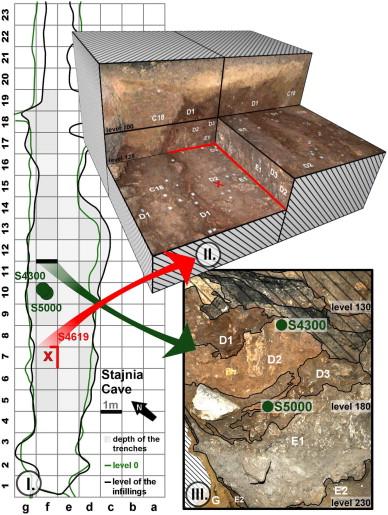A Neanderthal lower molar from Stajnia Cave, Poland
P. Dąbrowskia, W. Nowaczewskab, C.B. Stringerc, T. Comptonc, R. Kruszyńskic, A. Nadachowskid, K. Stefaniake, M. Urbanowskif
Source - http://www.sciencedirect.com/science/article/pii/S0018442X13000139
Journal of Evolution
Abstract
The primary aim of this study was to conduct a taxonomic assessment of the second of three isolated human teeth found in the Stajnia Cave (north of the Carpathians, Poland) in 2008. The specimen was located near a human tooth (S5000), which was identified by Urbanowski et al. (2010) as a Neanderthal permanent upper molar. Both of these teeth were excavated from the D2 layer, which belongs to the D stratigraphic complex comprising the archaeological assemblage associated with the Micoquian tradition. An Ursus spelaeus bone and Mammuthus primigenius tooth that were also excavated from the D2 layer were dated to >49,000 years BP (by AMS 14C) and 52.9 ka BP (by U-Th), respectively. The sediment overlying stratigraphic complex D was dated to 45.9 ka BP by the OSL method. The S4300 tooth is a lower first or second permanent molar belonging to an individual other than that who once possessed the S5000 tooth. The S4300 tooth exhibits a combination of traits typical of Neanderthal lower molars, including a mid-trigonid crest, large anterior fovea, taurodontism and subvertical grooves on the interproximal face, indicating that this tooth belonged to a Neanderthal individual. The S4300 tooth from Stajnia Cave is one of the oldest human remains found in Poland.
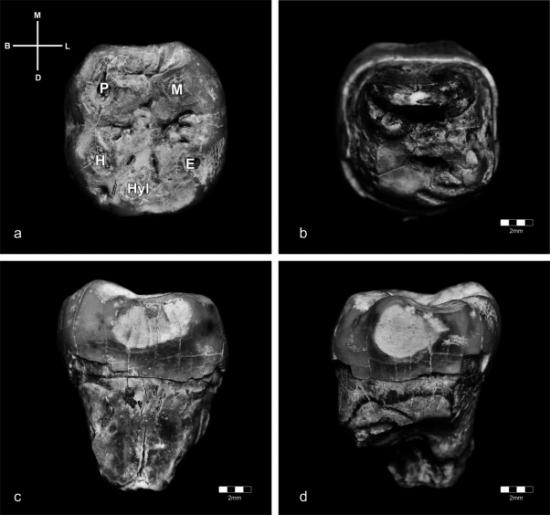
Fig. 2. S4300: (a) occlusal surface of the crown exhibiting main cusps: P – protoconid, M – metaconid; E – entoconid; H – hypoconid; Hyl – hypoconulid and groove pattern. (b) Apical view of the molar showing the preserved parts of two roots: mesial and distal. (c) Mesial view of the molar showing an interproximal wear facet with subvertical grooves and a preserved part of the mesial root. (d) Distal view of the molar showing an interproximal wear facet without subvertical grooves and a preserved part of the distal root.
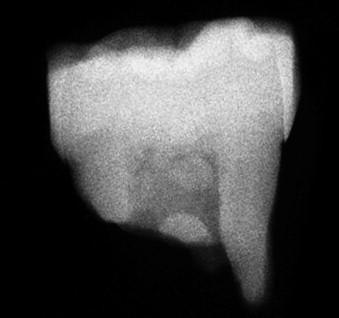
Fig. 4. X-ray of the S4300 molar. Presence of taurodontism – a relatively enlarged pulp cavity is visible.
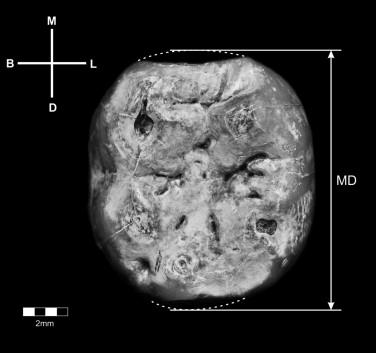
Fig. 5. S4300: corrected mesiodistal (MD) crown diameter.
The tooth of a Neanderthal child from Stajnia Cave, Poland
Wioletta Nowaczewskaa , Paweł Dąbrowskia, Chris B. Stringerb, Tim Comptonb, Rob Kruszyńskib, Adam Nadachowskic, Paweł Sochad, Marcin Binkowskie, Mikołaj Urbanowskif
Source - http://www.sciencedirect.com/science/article/pii/S0047248413000043
Journal of Evolution
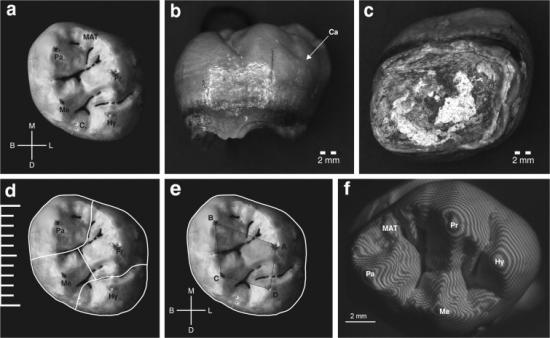
Figure 2. S4619, Neanderthal right molar a) occlusal view. Abbreviations: Pr: protocone, Pa: paracone, Me: metacone, Hy: hypocone; C5: metaconule (Cusp 5 – distal accessory tubercle), MAT: mesial accessory tubercle. b) Lingual aspect of the protocone – Ca (Carabelli's trait) is visible. c) Inferior view. d) Outlines depicting individual cusp base areas. e) The occlusal polygon described by the cusp apices of the protocone (A), paracone (B), metacone (C) and hypocone (D). f) Moiré contourogram of S4619 M crown. The main four occlusal cusps (Pr, Pa, Me, Hy) and MAT (mesial accessory tubercle) are visible. Orientation for figures: a), d), and e) M: mesial, D: distal, B: buccal, L: lingual.
